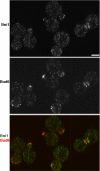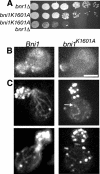Yeast formins Bni1 and Bnr1 utilize different modes of cortical interaction during the assembly of actin cables
- PMID: 17344480
- PMCID: PMC1855024
- DOI: 10.1091/mbc.e06-09-0820
Yeast formins Bni1 and Bnr1 utilize different modes of cortical interaction during the assembly of actin cables
Abstract
The budding yeast formins Bni1 and Bnr1 control the assembly of actin cables. These formins exhibit distinct patterns of localization and polymerize two different populations of cables: Bni1 in the bud and Bnr1 in the mother cell. We generated a functional Bni1-3GFP that improved the visualization of Bni1 in vivo at endogenous levels. Bni1 exists as speckles in the cytoplasm, some of which colocalize on actin cables. These Bni1 speckles display linear, retrograde-directed movements. Loss of polymerized actin or specifically actin cables abolished retrograde movement, and resulted in depletion of Bni1 speckles from the cytoplasm, with enhanced targeting of Bni1 to the bud tip. Mutations that impair the actin assembly activity of Bni1 abolished the movement of Bni1 speckles, even when actin cables were present. In contrast, Bnr1-GFP or 3GFP-Bnr1 did not detectably associate with actin cables and was not observed as cytoplasmic speckles. Finally, fluorescence recovery after photobleaching demonstrated that Bni1 was very dynamic, exchanging between polarized sites and the cytoplasm, whereas Bnr1 was confined to the bud neck and did not exchange with a cytoplasmic pool. In summary, our results indicate that formins can have distinct modes of cortical interaction during actin cable assembly.
Figures









References
-
- Asakura T., et al. Isolation and characterization of a novel actin filament-binding protein from Saccharomyces cerevisiae. Oncogene. 1998;16:121–130. - PubMed
Publication types
MeSH terms
Substances
LinkOut - more resources
Full Text Sources
Molecular Biology Databases
Miscellaneous

